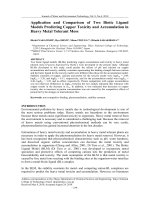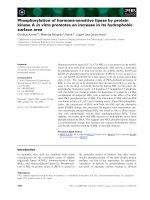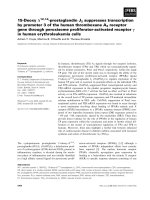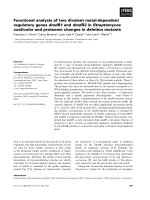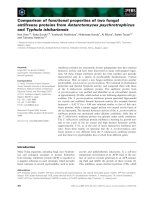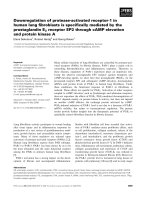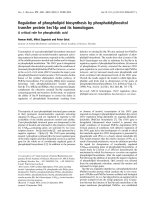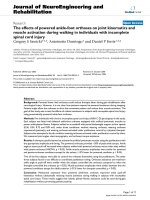Investigation of the roles of two rac1 effectors phosphatidylinositol 5 kinase 1a and p21 activated kinase 1 in insulin secreting cells
Bạn đang xem bản rút gọn của tài liệu. Xem và tải ngay bản đầy đủ của tài liệu tại đây (3.59 MB, 182 trang )
INVESTIGATION OF THE ROLES OF TWO RAC1
EFFECTORS PHOSPHATIDYLINOSITOL-5 KINASE Iα AND
P21-ACTIVATED KINASE 1 IN INSULIN-SECRETING
CELLS
ZHANG JIPING
NATIONAL UNIVERSITY OF SINGAPORE
2008
INVESTIGATION OF THE ROLES OF TWO RAC1
EFFECTORS PHOSPHATIDYLINOSITOL-5 KINASE Iα
AND P21-ACTIVATED KINASE 1 IN INSULIN-
SECRETING CELLS
ZHANG JIPING
(B.Sc., SICHUAN University)
A THESIS SUBMITTED
FOR THE DEGREE OF PHILOSOPHY OF DOCTORATE
DEPARTMENT OF BIOCHEMISTRY
NATIONAL UNIVERISTY OF MEDICAL INSTITUTES
NATIONAL UNIVERSITY OF SINGAPORE
2008
i
ACKNOWLEDGEMENTS
First of all, I would like to express my sincere appreciation and thanks to my
supervisor A/P Li Guodong for his invaluable guidance, support and
encouragement during the course of this research. This research would not have
been possible without his insightful ideas.
Many thanks to all my fellow lab-mates, Jingsong, Xiefei, Ruihua, Heqing,
Songhooi, Shiying and Michelle, in NUMI for the useful discussion sessions that
helped me throughout the research. My appreciation also goes out to my friends,
Shugui, Xiying, Xiaowei and Chenwei who helped me tremendously all along and
provided me with many useful inspirations.
Special thanks to my devoted parents, who offered me with never ending supports,
encouragements and the very academic foundations that make everything possible.
Not to forget my husband who had always cared and encouraged me these years.
Finally, I would like to thank the National University of Singapore for facilities and
generous financial support that makes this research project a success.
This work was supported by the grant from the National Medical Research Council
of Singapore (NMRC 0803/2003).
ii
PUBLICATION LIST
Full papers:
1. Zhang J, Luo R, Li GD. Effects of knockdown of type Iα phosphatidylinositol-4-
phosphate 5-kinase on insulin secretion and glucose metabolism in INS-1 β-cells.
Endocrinology, May 2009, 150(5):2127-2135
2. Li GD, Luo R, Zhang J, Yeo KS, Lian Q, Xie F, Tan EKW, Caille D, Kon O.L, Salto-
Tellez M, Meda P, and Lim SK. Generating mESC-derived insulin-producing cell lines
through an intermediate lineage-restricted progenitor line. Stem Cell Res, Volume 2,
Issue 1, January 2009, Pages 41-55
3. Li GD, Luo R, Zhang J, Yeo KS, Xie F, Tan EKW, Caille D, Que J, Kon O.L, Salto-
Tellez M, Meda P, and Lim SK. Derivation of functional insulin-producing cell lines
from primary mouse embryo culture. Stem Cell Res, Volume 2, Issue 1, January 2009,
Pages 29-40
4. Li J, Luo R, Hooi S, Ruga P, Zhang J, Meda P and Li GD. (2005) Ectopic expression
of syncollin in INS-1 beta-cells sorts it into granules and impairs regulated secretion.
Biochemistry-US 44:4365-4374
5. Zhang J, Luo R, Li GD. Knockdown of p21-activated kinase 1 protects insulin-
secreting INS-1 cells from high glucose-induced apoptosis. in preparation
Conference papers:
1. Zhang J, Luo R, Li GD. (2008) Attenuation of high glucose-induced INS-1 cell
apoptosis by knocking down an isoform of P21-activated kinase (PAK). Diabetes
57(suppl. ):A?; Poster presentation at 68
th
ADA Annual Scientific Sessions, 6-10 June,
2008, San Francisco, CA, USA.
2. Zhang J, Luo R, Xie F, Li GD. (2007) Knockdown of a downstream effector of the
small G-protein Rac 1 by siRNA affects glucose metabolism and insulin secretion in
INS-1 β-cells. Diabetologia 50 (suppl. 1):S88; oral presentation at 43rd Annual
Meeting of the European Association for the Study of Diabetes (EASD), Amsterdam,
The Netherlands, 17-21 Sep 2007
3. Zhang J, Teh SH, Luo RH, Xie F, Li, GD. (2007) Involvement of type Iα
phosphatidylinositol-4-phosphate 5-kinase in glucose-induced insulin secretion in INS-
1 cells. Presented at 67
th
ADA Annual Scientific Sessions, 21-26 June, 2007, Chicago,
IL, USA. Diabetes 56(suppl. 1): A435
4. Li GD, Luo R, Kon OL, Salto-Tellez M, Xie F, Zhang J, Lim SK. (2006)
Differentiation of embryonic progenitor cells into insulin-producing cells for diabetes
therapy. P.67-8, Abstract Collection. Oral presentation at the 5
th
Asian-Pacific
Organization for Cell Biology (APOCB) Congress, P.R. China / Beijing, 28-31 Oct
2006
iii
5. Li GD, Luo R, Xie F, Zhang J, Kon OL, Salto-Tellez M, and Lim SK. (2006) Deriving
insulin-producing cells from the embryonic progenitor for treatment of Type 1 diabetes.
Mol Biol Cell 17(suppl.):2102 (CD-ROM).
6. Li GD, Luo R, Zhang J, Kon OL, Salto-Tellez M, Xie F, and Lim SK. (2006) Insulin-
producing Cells Derived from Embryonic Progenitor Cells Reverse Hyperglycemia in
Streptozotocin-induced Diabetic Animals. Diabetes 55(suppl. 1): A22. Invited speaker
at ASCB’s 46
th
annual meeting
7. Li GD, Luo R, Zhang J, Kon OL, Salto-Tellez M, Xie F, Meda P and Lim SK. (2006)
Generation of insulin-producing cells from embryonic progenitor cells for
transplantation in type 1 diabetic mice. In: Poster Session Abstracts book, p191.
Accepted for presentation at the 4th ISSCR Annual Meeting, 29 June - 1 July, 2006,
Toronto, Ontario, Canada
8. Zhang J, Luo R, Kon OL, Xie F, Lim SK and Li GD. (2005) Generation and
verification of functional insulin-producing cells derived from embryonic progenitor
cells. Mol Biol Cell 16(suppl.):386a (CD-ROM)
9. Zhang J, Luo R, Kon OL, Xie F, Lim SK and Li GD. (2005) Generation and
characterization of insulin-producing cells derived from mouse embryonic progenitor
Cells. Ann Acad Med Sing 34(suppl): S213, Basic Science Poster Award at Combined
Scientific Meeting 2005, Singapore
10. Li GD, Luo R, Xie F, Zhang J and Lim SK. (2005) Long term propagation and
functionality of insulin-producing cells derived from mouse embryos. Accepted for
presentation at the 3rd ISSCR Annual Meeting, 23-25 June 2005, San Francisco, CA,
USA
11. Li J, Zhang J and Li GD (2005) Glucose and forskolin induced translocation of
phosphatidylinositol 4-phosphate 5-kinase in insulin-secreting INS-1 cells is coupled
with Rac1 activation. Diabetes 54(suppl. 1): A421
12. Li GD, Luo R, Zhang J, Xie F and Lim SK. (2005) Insulin-producing Cells Derived
from Mouse Embryo Exhibit Functional Secretory Responses to Secretagogues.
Diabetes 54(suppl. 1): Accepted but withdrawn
iv
TABLE OF CONTENTS
ACKNOWLEDGEMENTS i
PUBLICATION LIST ii
TABLE OF CONTENTS iv
SUMMARY vii
LIST OF TABLES AND FIGURES ix
ABBREVIATIONS xii
CHAPTER 1 INTRODUCTION 1
1.1 General background 2
1.1.1 Diabetes mellitus and β-cell malfunction 2
1.1.2 Effect of hyperglycemia on β-cells 3
1.1.3 Insulin biosynthesis 3
1.1.4 Regulation of insulin secretion 5
1.1.5 Insulin granules exocytosis 6
1.2 Rho GTPases, cytoskeleton, insulin secretion and viability of β-cells 8
1.2.1 Re-organization of cytoskeleton in exocytosis 8
1.2.2 Regulators of cytoskeleton involved in exocytosis 9
1.2.3 insulin-secreting cell models for pancreatic β-cell 10
1.2.4 Role of Rho GTPases in exocytosis 11
1.2.5 Role of Rac in cell viability 12
1.3 Effectors act downstream of small G-protein Rac1 13
1.3.1 Phosphatidylinositol-4-phosphate 5-kinase (PIP5K) 14
1.3.1.1 Nomenclature of PIP5K 14
1.3.1.2 Structure and distribution of PIP5K 15
1.3.1.3 Regulation of PIP5K 17
1.3.1.4 Biological function of PIP5K and PIP
2
18
1.3.1.5 Potential role of PIP5K in insulin secretion 22
1.3.2 P21-activated kinase (PAK) 23
1.3.2.1 Nomenclature of PAK 23
1.3.2.2 Structure of PAK 24
1.3.2.3 Regulation and activation of PAK 25
1.3.2.4 Downstream effectors of PAK and their biological functions 26
1.3.2.5 Glucotoxicity-induced pancreatic β-cell death 30
1.3.2.6 Potential role of PAK in glucotoxicity-induced β cell death 34
1.4 Aim and significance 35
CHAPTER 2 MATERIALS AND METHODS 37
2.1 Materials 38
2. 2 Methods 42
2.2.1 INS-1 cell culture and storage 42
2.2.2 Molecular biology 43
v
2.2.2.1 E.Coli transformation 43
2.2.2.2 Plasmid DNA preparation 43
2.2.2.3 RNA purification 45
2.2.2.4 Reverse transcription, polymerase chains reaction and Real-time
PCR 46
2.2.2.5 Transfection 48
2.2.2.5.1 Reverse transfection of siRNA duplexes 48
2.2.2.5.2 Transient transfection of GFP-PLC plasmid and PIP
2
distribution assay 50
2.2.2.6 Measurement of DNA content 51
2.2.3 Protein assay 51
2.2.3.1 Protein extraction 51
2.2.3.2 Measurement of protein concentrations 52
2.2.3.3 Western Blotting 53
2.2.3.4 Phospho-JNK ELISA 54
2.2.4 Measurement of insulin secretion 55
2.2.5 Observation of cell morphology and assessment of F-actin filaments 56
2.2.6 Measurement of membrane potential 57
2.2.7 Measurement of intracellular Ca
2+
concentration at basal and upon
glucose stimulation 58
2.2.8 Glucose metabolism 59
2.2.8.1 Assessment of glucose metabolism by MTS assay 59
2.2.8.2 Glucose oxidation 59
2.2.9 IP
3
formation assay 60
2.2.10. Examination of cell growth and death 61
2.2.11 Caspase activity assay 62
2.2.12 ROS assay 63
2.2.13 Statistical analysis 64
CHAPTER 3 RESULTS 65
3.1 The role of PIP5K-Iα in insulin secretion 66
3.1.1 Knockdown of PIP5K-Iα at mRNA and protein level 66
3.1.2 Knockdown of PIP5K-Iα induces changes in cell morphology and
cytoskeleton 69
3.1.3. PIP5K-Iα knockdown reduces PIP
2
in the plasma membrane and
abolishes PIP
2
redistribution during glucose stimulation, but has no
effect on IP
3
formation 73
3.1.4 Knockdown of PIP5K-Iα affects insulin secretion 75
3.1.4.1 PIP5K-Iα knockdown inhibits stimulated insulin secretion but
augments basal insulin release 75
3.1.4.2 PIP5K-Iα knockdown inhibits both the early and late phase of
insulin secretion 78
3.1.5 Knockdown of PIP5K-Iα affects glucose metabolism 79
3.1.6 Knockdown of PIP5K-Iα depolarizes the basal membrane potential 81
3.1.7 Knockdown of PIP5K-Iα affects intracellular [Ca
2+
]
i
83
3.1.8 Knockdown of PIP5K-Iα does not affect INS-1 cell growth and death
84
3.2 The role of PAK1 in glucotoxicity-induced cell death 86
3.2.1 Reverse transfection of siRNA duplexes knocks down PAK1 86
vi
3.2.2 PAK1 knockdown does not affect insulin secretion and actin
cytoskeleton in INS-1 cell 87
3.2.3 Knockdown of PAK1 does not affect cell cycle at normal culture 89
3.2.4 Glucotoxicity induces INS-1 cell apoptosis 90
3.2.5 Chronic high glucose treatment increases PAK1 activation 95
3.2.6 Knockdown of PAK1 inhibits glucotoxicity-induced INS-1 cell death
96
3.2.7 PAK1 knockdown blocks high glucose induced activation of p38
MAPK 100
3.2.8 Inhibitors of p38 MAPK and JNK protects INS-1 cells from
glucotoxicity-induced apoptosis 103
3.2.9 Expression of a dominant negative Rac1 mutant aggravates high
glucose induced cell apoptosis 105
3.2.10 PAK1 knockdown has no effect on glucotoxicity induced oxidative
stress 106
CHAPTER 4 DISCUSSION 107
4.1. Roles of PIP5K-Iα in insulin-secreting cells 109
4.1.1. Involvement of PIP5K-Iα in cell morphology and actin cytoskeleton
organization in INS-1 cells 110
4.1.2. Role of PIP5K-Iα in insulin secretion in INS-1 cells 111
4.1.3. Implication of PIP5K-Iα in PIP
2
production in INS-1 cells 115
4.1.4. Role of PIP5K-Iα in glucose metabolism and membrane potential 118
4.2 The role of PAK1 in glucotoxicity-induced β-cell apoptosis 121
4.2.1 PAK1 knockdown has no effect on either F-actin cytoskeleton or
insulin secretion 121
4.2.2 The protective role of PAK1 knockdown from glucotoxicity induced β-
cell death 123
4.2.3 PAK1 knockdown attenuated glucotoxicity-induced caspase-3
activation 125
4.2.4 The role of PAK1 activators in glucotoxicity 126
4.2.5 PAK1 knockdown blocked p38MAPK activation upon prolonged
exposure to high glucose 127
4.3 Conclusions 131
4.4 Future work 132
4.4.1 Future work for the study of PIP5K-Iα 132
4.4.2 Future work for the investigation of PAK1 134
REFERENCE LIST…………………………………………………………… 135
vii
SUMMARY
Insulin plays an essential role in the maintenance of homeostasis of blood glucose,
which relies on an adequate mass and functional insulin secretion in pancreatic β-
cells. It has been proven that the small G-protein Rac1 participates in glucose- and
cAMP-induced insulin secretion. This effect is accomplished probably through
maintaining a functional actin structure for recruitment of insulin granules. Both
phosphatidylinositol-4-phosphate 5-kinase Iα (PIP5K-Iα) and p21-activated kinase
1 (PAK1), the downstream effectors of Rac1, are suggested to be involved in
mediating the action of Rac1 on actin cytoskeleton remodeling. In this thesis study,
their potential roles in insulin secretion and cell survival were investigated in INS-1
cell line, a widely-used pancreatic β-cell model. Using RNA interference technique,
effective knockdown of PIP5K-Iα and PAK1 was achieved by reverse transfection
of the targeting siRNA duplexes.
PIP5K-Iα knockdown disrupted F-actin structure and caused changes in cell
morphology. In addition, the content of its product, phosphatidylinositol-4,5-
bisphosphate (PIP
2
), on plasma membrane was reduced and the glucose effect of
PIP
2
hydrolysis was abolished by PIP5K-Iα knockdown. Although total insulin
secretion in response to glucose and other stimuli was increased in PIP5K-Iα
knockdown cells, the incremental insulin release over basal (2.8 mM glucose)
stimulated by high glucose and forskolin was inhibited. However, at resting status,
PIP5K-Iα knockdown increased glucose metabolism, depolarized membrane
potential, raised cytoplasmic free Ca
2+
levels ([Ca
2+
]
i
), and doubled insulin secretion.
In contrast, metabolism and [Ca
2+
]
i
rises at high glucose were diminished. These
results indicate that PIP5K-Iα may play a complex role in both the proximal and
viii
distal steps of signaling cascades towards insulin secretion in β-cells, besides
mediating the effect of Rac1 on actin cytoskeleton organization.
On the other hand, PAK1 knockdown had no apparent effect on both F-actin
cytoskeleton and insulin secretion by various stimuli. However, PAK1 knockdown
attenuated INS-1 cell apoptosis and caspase-3 activation due to prolonged exposure
to high (20 or 30 mM) glucose (glucotoxicity). In addition, glucotoxicity also led to
activation of caspase-8 and -9, suggesting the involvement of both extrinsic and
intrinsic apoptotic pathways. Prolonged exposure to high glucose activated PAK1
and several mitogen-activation protein kinases (MAPKs), including p44/42 MAPK,
p38 MAPK and c-jun-N-terminal kinase (JNK). However, it appeared that only
p38 MAPK was activated downstream of PAK1 upon glucotoxicity. Moreover, both
inhibitors for p38 MAPK and JNK were able to alleviate INS-1 cells from
glucotoxicity-induced apoptotic death. This suggests that p38 MAPK, at least
partially, mediated the protective role of PAK1 from glucotoxicity induced
apoptosis.
The data from this thesis work has demonstrated that both PIP5K-Iα and PAK1 play
important roles in β-cells. The former may function as a downstream effector to
mediate Rac1-induced organization of F-actin structure and regulation of insulin
secretion, whereas the latter may be involved in the control of β-cell apoptosis and
glucotoxicity. These results improved the understanding of β-cell biology and the
molecular mechanism for pathogenesis of diabetes.
ix
LIST OF TABLES AND FIGURES
Table 1. PIP5K family………………………………………………… …… … 17
Table 2. PAK family…………………………………………………… …… ….24
Table 3. Material and sources 38
Table 4. Programs of PCR……………………………………………………… 47
Table 5. Primers used for SYBR Green based real-time PCR…………… ………48
Table 6. Sequences of siRNA duplex targeting interested mRNA.………………. 49
Table 7. Conditions of critical factors in Western blotting …………………… …54
Fig. 1. Schematic diagram for the possible role of downstream effectors of Rac in
insulin secretion. 14
Fig. 2. Transfection efficiency of small RNA oligos in INS-1 cells 67
Fig. 3. Knockdown of PIP5K-Iα at both mRNA and protein level in INS-1 cells. 69
Fig. 4. Knockdown of PIP5K-Iα induced change in cell morphology. 70
Fig. 5. Disruption of F-actin structure and reduction of F-actin content in INS-1
cells after PIP5K-Iα knockdown 72
Fig. 6. Knockdown of PIP5K-Iα reduced PIP
2
on the plasma membrane and
suppressed the glucose effect on PIP
2
74
Fig. 7. Production of IP
3
in INS-1 cells. 75
Fig. 8. PIP5K-Iα knockdown did not alter insulin content but affected high glucose
and forskolin induced insulin secretion in INS-1 cells. 77
Fig. 9. Effects of PIP5k-Iα knockdown on two phases of insulin secretion in INS-1
cells. 79
Fig. 10. PIP5K-Iα knockdown reduced metabolism at high glucose but increased
metabolism at basal glucose 81
Fig. 11. PIP5K-Iα knockdown depolarized resting membrane potential 82
Fig. 12. PIP5K-Iα knockdown had no effect on expression of Kir6.2 and SUR1, two
subunits of K
ATP
channel at mRNA level. 83
x
Fig. 13. PIP5K-Iα knockdown increased basal [Ca
2+
]
i
but decreased [Ca
2+
]
i
upon
glucose stimulation. 83
Fig. 14. PIP5K-Iα knockdown neither changed cell cycle nor induced apoptosis in
INS-1 cells. 85
Fig. 15. Knockdown of PAK1 in INS-1 cells. 87
Fig. 16. F-actin structure staining (A) and measurement of F-actin content (B) in
INS-1 cells after PAK1 knockdown. 88
Fig. 17. PAK1 knockdown did not affect insulin content or insulin secretion in INS-
1 cells. 89
Fig. 18. No effect of PAK1 knockdown on cell cycle upon culture at regular glucose
concentration (11 mM). 90
Fig. 19. Time-course of cell death induced by prolonged exposure to elevated
glucose. 91
Fig. 20. Time-course of glucotoxicity induced activation of caspase-3. 92
Fig. 21. Time-course of glucotoxicity induced activation of caspase-8 and caspase-9.
94
Fig. 22. A general caspase inhibitor (Z-VAD-FMK) blocked glucotoxicity induced
cell death. 95
Fig. 23. Activation of PAK1 after long-term exposure to elevated glucose 96
Fig. 24. PAK1 knockdown prevented changes of cell morphology and detachment
induced by treatment of high glucose. 97
Fig. 25. PAK1 knockdown protected INS-1 cell from glucotoxicity induced cell
death 99
Fig. 26. PAK1 knockdown suppressed caspase-3 activation 100
Fig. 27. High glucose induced activation of p44/42 MAPK and p38 MAPK. 101
Fig. 28. PAK1 knockdown suppressed high glucose-induced p38 MAPK activation.
102
Fig. 29. JNK activation upon high glucose treatment 103
Fig. 30. Specific inhibitors for p38MAPK and JNK but not p44/42 MAPK protected
INS-1 cells from high glucose induced cell death. 104
Fig. 31. Expression of dominant negative N17-Rac1 increased high glucose-induced
cell death. 105
xi
Fig. 32. Reactive oxygen species (ROS) production was increased upon prolonged
high glucose culture. 106
Fig. 33. Schematic diagram for the role of PIP5K-1α in actin cytoskeleton and
glucose stimulated insulin secretion. 111
Fig. 34. Schematic diagram for the role of MAPKs and PAK1 in glucotoxicity-
induced β-cell apoptosis 131
xii
ABBREVIATIONS
All abbreviations are defined where they first appear in the text and some of the
frequently used abbreviations are listed below.
Ac-CoA acetyl-coenzyme A
Ac-DEVD-AFC
Ac-Asp-Glu-Val-Asp-AFC
Ac-IETD-AFC Ac-Ile-Glu-Thr-Asp-AFC
Ac-LEHD-AFC Ac-Leu-Glu-His-Asp-AFC
ADF actin depolymerizing factor
AFC 7-amino-4-trifluoromethyl coumarin
AGEs advanced glycation end products
AID autoinhibitory domain
AMP Adenosine 3’-monophosphate
ATP adenosine 5’-triphosphate
BSA bovine serum albumin
[Ca
2+
]
i
cytoplasmic free Ca2+ concentration
cAMP Adenosine 3’,5’-cyclic monophosphate, cyclic AMP
CRIB Cdc42/Rac interactive binding
CDK caspase-dependent kinase
CHAPS 3-[(3-cholamidopropyl)dimethylammonio]-1-propanesulfonic
acid
DAG diacylglycerol
DCF 2',7'-dichlorofluorescein
DEPC diethyl pyrocarbonate
xiii
DFDA dihydrofluorescein diacetate
DMSO dimethyl sulphoxide
DPBS Dulbecco’s phosphate buffered saline
DNA deoxyribonucleotide acid
DTT dithiothreitol
EDTA ethylenediaminetetraacetic acid
EGTA ethylene glycol-bis(beta-Aminoethyl ether)-N,N,N’,N’-
tetraacetic acid
ELISA enzyme-linked immunosorbent assay
ERKs extracellular signal-regulated kinases
FITC fluorescein-5-isothiocyanate
GIP gastric insulinotropic polypeptide
GLP glucagons-like peptide
Glut2 glucose transporter-2
GSIS glucose stimulated insulin secretion
GTP guanosine triphosphate
HEPES N-[2-hydroxyethyl] piperazine-N’-[2-ethanesulfonic acid]
HUVECs human umbilical vein endothelial cells
HRP horseradish peroxidase
IL-1β
interleukin-1 β
IP
3
inositol 1,4,5-trisphosphate
JNK Jun amino terminal kinase
kDa kilo-Dalton
LDCV large dense-core vesicle
MAPK Mitogen-activated protein kinases
xiv
MCF metabolic coupling factors
MLCK myosin
light chain kinase
MLK Mixed lineage kinase
MTOC microtubule organizing centers
MTS 3-(4,5-dimethylthiazol-2-yl)-5-(3-carboxymethoxyphenyl)-
2-(4-sulfophenyl)-2H-tetrazolium
NADPH nicotinamide adenine dinucleotide phosphate
NBCS new born calf serum
NOXes nicotinamide adenine dinucleotide phosphate (NADPH)
oxidases
PA phosphatidic acid
PACAP pituitary adenylate cyclase activating protein
PAGE polyacrylamide gel electrophoresis
PAK P21-activated kinases
PBD P21-binding domain
PBS phosphate-buffered saline
PC1/3 prohormone convertases
PEP priming in exocytosis proteins
PI phosphatidylinositol
PI3k Phosphoinoitide 3-kinase
PIP
2
phosphoinositol-4,5-bisphosphate
PIP5K phosphatidylinositol-4-phosphate 5-kinase
PIP5K Iα
type Iα phosphatidylinositol-4-phosphate 5-kinase
PIX PAK interacting guanine exchange factor
PKA cAMP dependent protein kinase
xv
PLC phospholipase C
PLD phospholipase D
PMS phenazine methosulfate
PMSF phenylmethylsulfonyl fluoride
PtdIns[4]P phosphatidylinositol 4-phosphate
PtdIns[5]P phosphatidylinositol 5-phosphate
PVDF polyvinylidene difluoride
RER rough endoplasmic reticulum
RISC RNA induced silencing complex
R-MLC regulatory myosin light chain
RNA ribonucleotide acid
ROS reactive oxygen species
RNAi RNA interference
RRP ready releasable pool
SDS sodium dodecyl sulphate
shRNA short hairpin RNA
siRNA short interference RNA
SNAP soluble N-ethylmaleimide-sensitive factor
attachment protein
SNARE soluble N-ethylmaleimide-sensitive factor
attachment protein
receptor
SRP signal recognition particle
TBS Tris-buffered saline
TBS-T TBS with 0.5% Tween-20
T1DM Type 1 diabetes mellitus
T2DM Type 2 diabetes mellitus
xvi
TEMED N,N,N’,N’-tetra methylthylene diamine
TRITC tetramethyl rhodamine isothiocyanate
t-SNARE target membrane soluble
N-ethylmaleimide-sensitive factor
attachment protein (SNAP)
receptor
VAMP vesicle-attached membrane protein
Z-VAD-
FMK
benzyloxycarbonyl-Val-Ala-Asp-fluoromethyl ketone
Chapter 1. Introduction
1
CHAPTER 1
INTRODUCTION
Chapter 1. Introduction
2
1. Introduction
1.1 General background
1.1.1 Diabetes mellitus and β-cell malfunction
Diabetes mellitus is a disease characterized by chronic hyperglycemia and insulin
deficiency with or without insulin resistance. It affects more than 170 million people
worldwide in 2000, and the number is expected to be more than doubling by the end
of 2030 as estimated by world health organization (WHO) (1). Type 1 diabetes
(insulin-dependent diabetes mellitus) and type 2 diabetes (non-insulin-dependent
diabetes mellitus) represent the two major types of diabetes mellitus. Although, from
the epidemiological point of view, they are two distinct diseases, it is difficult to draw
a line between them. On the other hand, from a clinical point of view, type 1 and type
2 diabetes mellitus are often viewed as the two ends of spectrum with some
similarities overlapping in the middle. The middle-overlapping portion is the
dysfunction of insulin secretion, which is present in both types of diabetes to varying
degree.
Acting as insulin secreting cells, pancreatic β-cells play a critical role in the
development and progression of diabetes mellitus. Thousands of pancreatic β-cells are
located in a spherical cluster called islet of Langerhans (named after the discoverer in
1869), which scatter throughout the pancreas especially at the pancreas tail. Besides
pancreatic β-cells, the islet of Langerhans comprises a small quantity of other
endocrine cells (i.e. α, δ, and pp) (20-40%). In type 1 diabetes mellitus (T1DM),
autoimmune attack mediated by cytotoxic T-lymphocytes destroys pancreatic β-cells
thereby interrupting insulin secretion. Although the type 2 diabetes mellitus (T2DM)
Chapter 1. Introduction
3
is mainly due to insulin resistance, β-cell destruction by hyperglycemia is also
believed to be a critical etiological factor for its development (2). However, the β-cell
failure is not attributed solely to the loss of β-cell mass, but also the abnormal
function of the remaining β-cells. Hyperinsulinemia evoked by prolonged
hyperglycemia results in pancreatic β-cells exhaustion in type 2 diabetes. Thereafter,
the glucose stimulated insulin secretion (GSIS) is diminished and β-cell
dedifferentiated (3).
1.1.2 Effect of hyperglycemia on β-cells
Diabetes is the major risk factor for various cardiovascular complications. Chronic
hyperglycemia can cause not only vascular dysfunctions (4-6) but also deteriorate
functions of pancreatic β-cells (7-9). Elevated glucose concentrations can induce
impaired insulin biosynthesis and secretion and ultimately lead to β-cell death. This is
known as glucotoxicity (7-9). In fact, high concentrations of glucose have a dual
effect on β-cell mass turnover (10;11). Short-term exposure of human islets to
increased concentrations of glucose enhances insulin production and β-cell
proliferation, whereas prolonged exposure has toxic effects leading to impaired
insulin secretion (12;13) and β-cell apoptosis (14;15). A loss of β-cell mass is
implicated in both type 1 and type 2 diabetes; the former is due to autoimmune
destruction of islet β-cells whereas the latter is attributable to glucotoxicity to a large
extent.
1.1.3 Insulin biosynthesis
The physiological glucose homeostasis is maintained within a narrow range, which
mainly owes to the precise regulation of insulin secretion. The discovery of insulin
Chapter 1. Introduction
4
was awarded the Nobel Prize in 1921. Ever since the discovery, the insulin has
attracted interest of scientists from various fields of research.
Insulin is naturally created from the translation of insulin mRNAs (messenger
ribonucleotide acid). Initially, the insulin is in an inactive form, known as
preproinsulin, which is a single chain precursor, composed of 110 amino acids at
rough endoplasmic reticulum (RER). A signal peptide region of 24 amino acids
enriched with hydrophobic residues (at the amino terminus of preproinsulin) enables
it to translocate into the RER lumen via a series of interactions of the signal peptide
with the signal recognition particle (SRP) and the SRP-receptor in the RER membrane
(16). Consequently, the signal peptide is cleaved by a signal peptidase located on the
luminal side of RER membrane, and a prohormone of 86 amino acids, known as
proinsulin, is produced. Within the cisternae of RER, proinsulin is folded and
disulfide bonds are formed to generate the native tertiary structure. The structure
consists of a C-peptide (35 amino acids) at the center of the proinsulin sequence with
A-chain (21 amino acids) and B-chain (30 amino acids) at the two ends separately
(17). The two disulfide bonds between A-chain and B-chain enable them to remain
connected. In the native tertiary structure, proinsulin is transported to the Golgi
apparatus and then packed to clathrin-coated secretory granules budding from the
trans-Golgi. Within the Golgi apparatus and immature granules, proinsulin undergoes
a series of maturation steps. First, the prohormone convertases, PC1/3, clips off the C-
peptide from proinsulin to produce the biologically active insulin (51 amino acids),
comprised of the A-chain and the B-chain. Afterwards, an equal amount of C-peptide
and mature insulin are stored in secretary granules and secreted together upon
stimulation (18).
Chapter 1. Introduction
5
1.1.4 Regulation of insulin secretion
Pancreatic β-cells are able to secrete insulin appropriately in response to a wide range
of glucose levels. From the biochemical standpoint, the β-cells are specialized in their
high rate of glycolytic and insulin-independent glucose metabolism. These β-cells
have a unique ability that allows the cells to control the secretion using the available
metabolizable nutrients, without mediating the ligand-specific cell surface. The two
important glucose sensors, glucose transporter-2 (Glut2) and glucokinase, are critical
for glucose metabolism in β-cells (19). Upon diffused into β-cells through Glut2,
glucose is phosphorylated by glucokinase and metabolized into acetyl-coenzyme A
(Ac-CoA) through the glycolytic pathway. Ac-CoA is then further metabolized in
mitochondria, resulting in a rise of cellular ATP-to-ADP ratio, followed by closure of
ATP-sensitive K
+
(K
ATP
) channels, and hence leading to the depolarization of
membrane potential. Thereafter, the opening of voltage-operated Ca
2+
channels (20-
22) ensues and the increased of Ca
2+
influx elevates the cytoplasmic free Ca
2+
concentrations ([Ca
2+
]
i
). It is believed that such an increase of [Ca
2+
]
i
is the trigger
signal for insulin secretion. (23;24).
Besides glucose, the primary physiological stimulator for insulin secretion, there are
many other factors that are involved in the complex insulin secretion process. All of
these factors can be generally categorized into three groups: initiators, potentiators
and inhibitors (24). The initiator group consists of many nutrients, such as other
carbohydrates, amino acids and fatty acids. These nutrients are capable of initiating
insulin secretion on their own through metabolic coupling factors (MCF). Arginine,
on the other hand, initiates insulin secretion by depolarizing the plasma membrane in
a K
ATP
-channel independent manner due to its transport in a positive charge form (24-
27). In addition, typical pharmacological agents: sulphonylureas, e.g. tolbutamide and
Chapter 1. Introduction
6
glibenclamide, used for clinical treatment of diabetes, are potent K
ATP
-channel
blocker, and thereby able to initiate insulin secretion in the presence of moderate
glucose (24;28;29). Potentiators are secretagogues that are not able to initiate insulin
secretion directly by themselves, but they do enhance secretion in the presence of an
initiator. For instance, acetylcholine and cholecystokinin are able to promote
phosphoinositide breakdown and result in the mobilization of Ca
2+
from intracellular
stores and the activation of protein kinase C (PKC) (24;30). Other potentiators, gastric
insulinotropic polypeptide (GIP) (31), the intestinal glucoincretin hormones
glucagons-like peptide 1(GLP-1) (32), and pituitary adenylate cyclase activating
protein (PACAP), activate adenylate cyclase. This causes the rise in cyclic AMP
(cAMP) levels, which activate cAMP-dependent protein kinase A (PKA) followed by
potentiation of insulin secretion (24;31;33-35). In contrast, inhibitors are able to
reduce activation of adenylate cyclase, modify Ca
2+
and K
+
channel gating or directly
affect exocytosis to suppress insulin secretion. Inhibitors are comprised of
neurotransmitters and hormones such as somatostatin, glanin and adrenalin
(34;36;37).
1.1.5 Insulin granules exocytosis
Pancreatic β-cells show a biphasic insulin secretion process when exposed to abrupt
and sustained increase in the ambient glucose concentration. The biphasic pattern of
secretion starts with a rapid and transient increase of secretion (first phase) and then
followed by a slow and sustained secretion (second phase). There are two mechanism
models underlying this biphasic response: the “storage-limited model” and “the
signal-limited model” (20;33;38). According to the “storage-limited model”, insulin
granules are located in geographically and functionally distinct pools. They are the
Chapter 1. Introduction
7
readily releasable pool and the reserve pool. Release of insulin granules from readily
releasable pool gives rise to the first phase, followed by energy-consuming
recruitment of granules from reserve pool to the plasma membrane. The release of
these granules corresponds to the second phase of insulin secretion. However,
according to the “signal-limited model”, the biphasic response is a result of biphasic
triggering signals. In this model, the Ca
2+
influx acts as the triggering signal with
some unclear biochemical mechanisms amplifying the Ca
2+
efficacy. While these two
models have their own unique point of view, they are however not mutually exclusive
and both ideas could coexist (38-41).
Insulin stored in large dense core vesicles (LDCV), the secretory granules (diameter ≈
0.3 µm), is released by a series of steps in terms of exocytosis, involving the approach
of vesicles to the plasma membrane, followed by docking, priming, fusion with the
plasma membrane and finally release to the extracellular space. Upon stimulations,
even at the maximal stimulatory conditions, only a small proportion of insulin is
released by aforementioned exocytosis, whereas most of insulin is stored in secretory
granules (41). A healthy β-cell contains more than 13,000 insulin-containing granules.
However, only a small fraction, as low as 0.05% of granules, stay in the primed ready
releasable pool (RRP) (39;41). The recruitment of the insulin granules from
biosynthetic or storage pools in the cytoplasm to the plasma membrane is facilitated
by cytoskeleton including microtubules and microfilament. After reaching the plasma
membrane, insulin granules interact with plasma membrane reversibly in close
proximity to the exocytotic site, named docking. The priming of insulin granules is an
ATP-dependent irreversible process, in which, soluble N-ethylmaleimide-sensitive
factor
attachment protein receptor (SNARE) complex is formed and the generation of
phosphoinositol-4,5-bisphosphate (PIP
2
) is needed. Although, SNAREs were
